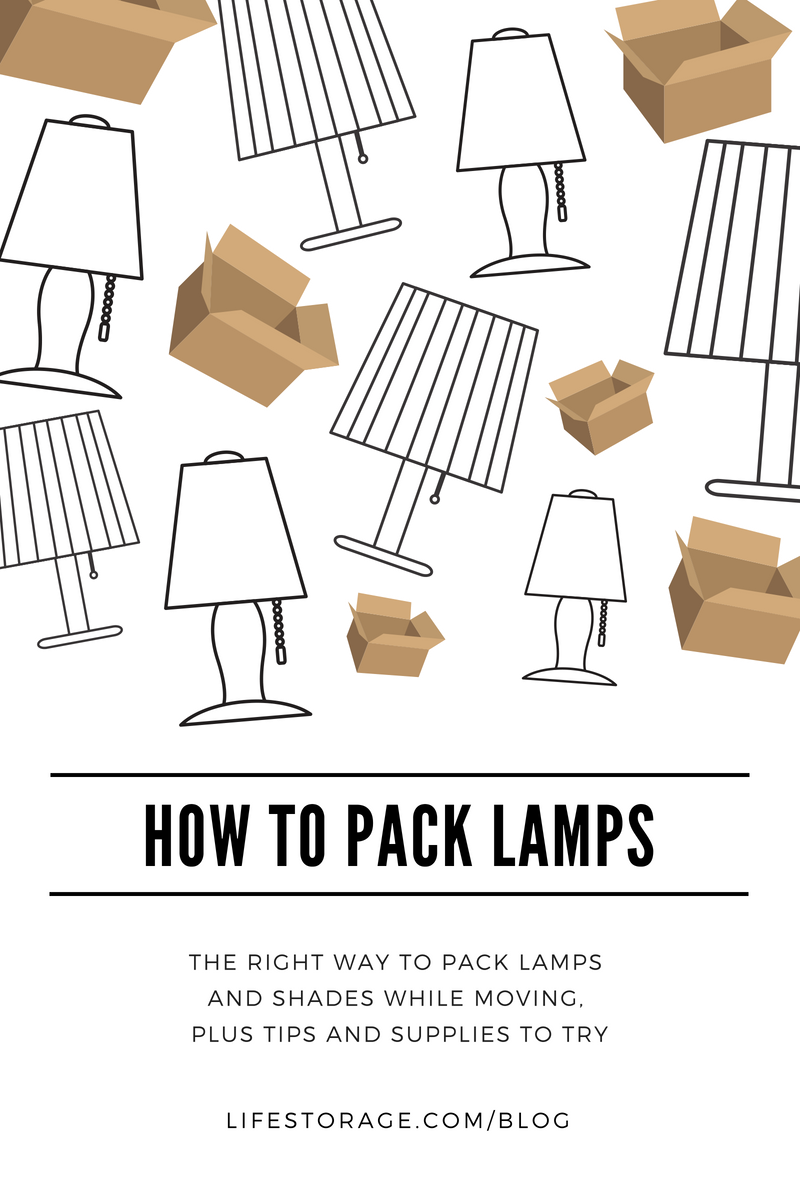
Lamps and lampshades are not easy to move from one place to another. They come with a lot of delicate parts, from thin metal harps to tissue-like shades to the glass of the bulb inside. But when the time comes for a move to a new house or apartment, how can you pack lamps and lampshades so they don’t break in the process?
You’ve worked hard to curate the perfect lighting collection in your home. If you’re preparing for a move, learning how to pack lamps and lampshades properly should be on your moving checklist. Read this post now or bookmark it for later!
How to Pack Lamps 101
If you still have the original box your lamp came in, case closed. You can’t do better than packing a lamp back in its original Styrofoam casing or structured cardboard supports. These are the packages that kept your lamps safe on their journey from the manufacturer to your home, with many potentially dangerous steps in between (think: delivery trucks and warehouses).
However, most of us don’t hold onto packaging material, in which case you should follow the steps below to safely protect a lamp during a move.
Supplies Need to Pack Lamps & Lampshades
Packing floor lamps, table lamps and all the rest involve a careful process of dismantling, prepping and packing. Here’s what you will need:
- A moving box big enough to fit the lamp shade
- Another moving box big enough to fit the lamp base
- Packing paper
- Painter’s tape
- Foam wrapping, packing peanuts or other filler
- A plastic bag
- A permanent marker
- Twist ties
Step #1: Dismantle the lamp, carefully.
We cannot stress this enough from the outset: Do not dismantle more than one lamp at a time! If you do, you might mix up pieces that are very difficult to un-mix.
That said, it’s time to take your lamp apart. Here’s how it’s done:
- Unscrew and remove the finial, or cap, at the top of the lamp. This is the piece that holds the lampshade secure on its base.
- Remove the shade riser–the piece of hardware that sits directly beneath the finial. (Note: Not all lamps have a shade riser.)
- Take off the lampshade.
- Remove the lightbulb.
- Remove the harp–the metal band that holds up the lampshade.
Step #2: Store all small hardware you removed from the lamp in a plastic bag.
Now we get to the heart of how to pack lamps. First, put all the hardware in the plastic bag and label it clearly with a descriptor of that particular lamp. Close the plastic bag and use painter’s tape to secure it to the harp. Consider numbering your lamps and labeling them with the painter’s tape to help keep hardware straight, in case your plastic bag separates from your lamp on moving day.
Step #3: Fold up and twist-tie the cord.
This step may seem unnecessary, but you’ll thank yourself later for doing it. Loose cords are a nuisance during the packing and moving process, and they also leave your light fixtures susceptible to damage. The cord can catch, causing the whole fixture to fall, or directly damaging the cord.
Step #4: Wrap foam around the prongs, cord and base of the lamp.
This will protect your lamp and its delicate features from bending or getting scratched.
Step #5: Wrap packing paper around the entire lamp.
This serves as a cushion for your lamp as it is moved inside its box. You could place the packing paper into the moving box above and below the lamp base instead of wrapping it around the lamp.
Step #6: Pack the lamp in its moving box.
Make sure the harp and hardware end up in the box with the base. Tape both smaller items to the inside of the box for extra safekeeping.
Step #7: Fill any extra space in the box with additional packing material.
This will limit the lamp’s ability to shift during transport. Try a shake test. If your lamp shifts as you shake the moving box, you could probably fit more packing material inside. This is where those packing peanuts–or an eco-friendly alternative–will come in handy.
Pro Tip: All out of packing paper? Grab those plastic bags from your supplies list. Fill a
few with air to create makeshift cushions for your moving boxes.
Step #8: Line your second moving box with packing paper and pack your lampshade on top, upended.
By packing your lamp shade upside down, you can nest other similar size or smaller shades inside.
Step #9: Fill the inside of the shade with more packing material.
The packing material that goes inside the shade will help it keep its shape. Don’t over-stuff it or the packing material will be the reason your shades come out misshapen when you unpack them! While newsprint can be used as packing paper in some cases, it’s not recommended for packing lampshades as the print can bleed onto the shade.

Step #10: Tape both boxes shut and label them.
We recommend taping each moving box twice: once in the direction of the flaps and once perpendicular to the flaps.
And that’s the best way to pack lamps and lampshades. See? Not so hard!
Packing Tips for Alternative Types of Lighting
If you’re packing alternative lighting, don’t fret. Lots of people have questions about chandeliers, but you can actually dismantle and pack them similarly to table lamps. Remove the finial from the bottom and slide the body of the chandelier off the rod, then pack the rod and hanging chain separately.
Alternatively, you might wonder about your decorative string lights. These are a little tougher since they’re easily squashed. It’s best to pack them in boxes by themselves, or else pack them in a container within a bigger box.
Keeping Your Lamps Safe in Storage
For most people, this is the end of the road: lamps packed, time to hit the road. But what if you’re not moving straight from one home into another?
In that case, the skinny on how to pack lamps is basically the same, with the caveat that you should avoid damp garages and basements wherever possible during the storage period. This is bad for the electrical, and can also cause damage to boxes and packing materials, harming your lamps in turn.
Actually, dampness is bad for all possessions, so you might want to consider a climate controlled storage environment, the better to protect your lighting collection (and everything else you are storing).
Other than that, you’re good to go! We wish you and your lamps the very best in your new home.






